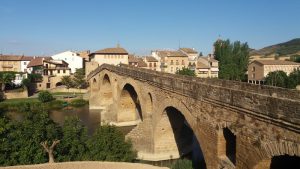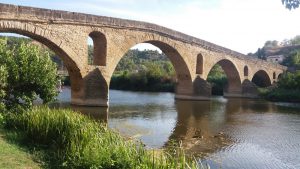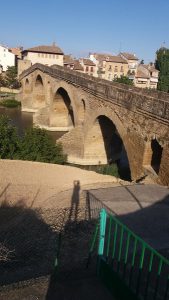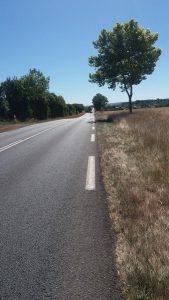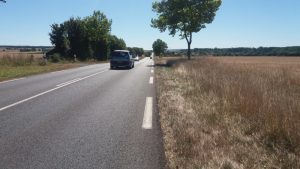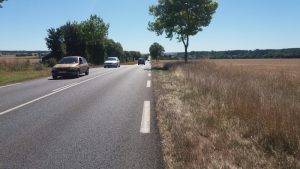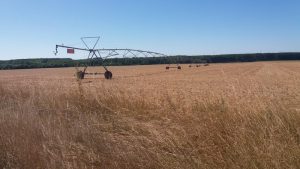I’m mostly pretty lucky with sleep. In the early camping nights on this journey I was waking up a lot though then I was getting pretty well straight back to sleep. I think that sleep pattern was down to unaccustomed noise, to temperature change meaning I might need to move from just the sleeping bag liner to the bag as well, even one or two nights, to a tee shirt as well. Quite often it has rained in the night after a cloudless day and before another day with no clouds at all, that seemed to be a weather pattern that was consistent. Then the unaccustomed noise of the rain and the temperature change that went with it would wake me. This is different. I’m in a cheap but excellent hotel. A “Hostal” I think. Oops, I really need to work on my Spanish, particularly categories of accommodation, though my “Un café cortado, per favor” is working well. That may have contributed as I’ve had very little coffee in three weeks and three coffees in six hours here today. No, it’s not the caffeine, the timing is all wrong, l woke at 02.15 having slept OK ’til then and my usual tricks, including reading rubbish detective stories, haven’t dented the problem so I’m wide awake and not feeling tired at all though the climb today was way away the hardest cycling I’ve done.
I suspect that the changes of country and language, and above all that last blog post I did, have stirred a bit of a beast that’s been lurking in wait until now.
One important part of that is about giving up doing formal psychotherapy, about giving up all clinical work, but the beast that came up in that post was all about sadness, and some bitterness, about how I feel the NHS changed. It’s not really in danger of becoming a McDonald’s of health, but something in the generally pretty stupid focus on “satisfaction”, PREMS and PROMS (Patient Rated Experience Measures and likewise, Outcome Measures) is so crude and depersonalising, and methdologically corrupt, that I think it does risk NHS care, perhaps particularly NHS Mental Health care, becoming like Jayne’s experience in that McDonald’s. (Oh, you can’t get a direct URL to a reply to a post, surely that’s a mistake on WordPress’s part. Her experience is in her reply to I had to go to McDonalds! — the continuing challenges of IT.)
I worry that I contributed to that.
I stopped there last night and read a Kindle book about one man’s camino on his bike ( ) and did sleep eventually. Today has been very mixed in many ways and sleep deprivation must have been a factor and it’s now late and I need to sleep so I’ll post this with a lot of links and formatting missing, and fix that another time However, I think I must return to that worry as it touches so many things I thought I would think about much more while I pushed pedals than I have so far. I’m sure I’ve been avoiding it.
OK, if you’re sitting comfortably then I’ll begin at the beginning.
I calculate my starting date in the NHS as the start of my clinical medical student three years at University College Hospital, so Autumn 1978. Two things hit me immediately, or probably more accurately, I held onto two of the thousands of things that hit me then, as I think the experiences hit any new clinical medical student like grape shot. One thing was the remarkably uncensored and trusting way that patients would share their life stories with us. The other was that the NHS seemed to be almost data phobic: it had incredible amounts of data, a tiny fraction of it went into computers, much, much less than 1% of what it had, and what did get computerised was mostly blood test results and some case registers. Next to nothing useful seemed to be made of that data.
Though I had no sense of it then, nor for quite a while, those things drove my working life from there. The stories, in a meandering way, I am sure made me a psychotherapist and I’ll come back to that and the other roots of my falling into psychotherapy another time. My belief that we could do much better with routine data led to much of my research career, and my most successful programme of work – co-inventing and then co-driving the CORE project (www.coresystemtrust.org.uk). “CORE” here stands for “Clinical Outcomes in Routine Evaluation”, a key part of what I was clear the NHS then was largely ignoring.
I’ve talked (“blogged”?) about CORE here a bit before (Copyright and sharing) and there is much in that work that is good but I do worry that CORE helped promote stupid change measurement and contributed, though never our intention, to a NHS managerial and political systems, even increasingly its clinical systems, that lose sight of the people, staff as well as patients, and their unique lives, stories and needs and wishes, replacing that complexity with largely meaningless numbers. I don’t believe the situation is hopeless, but I gave up trying to fight from the inside what I saw as misguided, some of it likely to produce poor results and waste money. That’s only one part of why I had to retire, but it was a huge part of the decision, and part of what I am trying to think usefully about on this trip. As I say, I think it has its insomniac and nightmare aspects and I think they bit me last night. OK, let’s see if getting that out, against all manner of continuing IT challenges, makes for an easier night.
